Text
Taxon Tuesday #6: Felidae

Felidae is the cat family. It contains all 36 extant cat species and their closely-related but unfortunately extinct comrades in genera such as Smilodon (a famous saber-toothed kitty). Some unifying traits among felids are: short faces, hypercarnivory (diet of 70%+ meat), large eyes adapted for dim light, retractable claws, highly sensitive ears, and solitary lifestyles. (There are obviously some exceptions...cheetahs have lost the ability to retract their claws, and lions live in complex social groups.)
Felidae is nested in the suborder Feliformia, alongside other cat-like carnivores such as hyenas, civets, and the fossa. Feliformia then combines with Caniformia (dog-like carnivores) to produce the order Carnivora.
The cat species of today are found across 14 genera, and partitioned into 8 lineages. One of those lineages belongs to the subfamily called Pantherinae, the big cats. The other seven are members of Felinae, the kitty cats. Extinct genera in Felidae include (but are certainly not limited to) Homotherium, Nimravides, Dinofelis, Miopanthera, and Proailurus, though their positions in the modern cat tree are still uncertain.
(In the graphic below, “+” indicates an extinct group.)
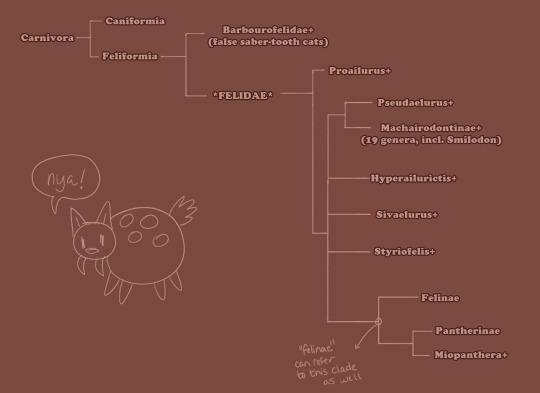
Sources Used:
https://en.wikipedia.org/wiki/Felidae
https://en.wikipedia.org/wiki/Machairodontinae
The Princeton Encyclopedia of Mammals (Macdonald, 2009)
4 notes
·
View notes
Text
Taxon Tuesday #5: Chondrichthyes
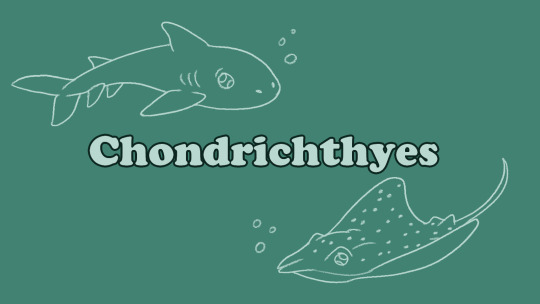
Chondrichthyes is the class that holds cartilaginous fishes (sharks, rays, skates, etc.) They’ve been around for well over 400 million years. Oldies but goodies am I right? Some of their distinguishing features are: skeletons made mostly of cartilage; skin covered in tooth-like placoid scales or denticles; teeth that are regularly shed and replaced; a piece of anatomy in males called a “pelvic clasper”, used for courtship and mating (I’m not looking that up for you sorry ✌)
These uncalcified friends are found in the clade Gnathostomata (jaw-having vertebrates). Their cousins are Placoderms (extinct armored fishies) and Euteleostomes (bony boys - includes bony fishies and tetrapods, or land-walking friends).
Chondrichthyes itself is divided into two major subclasses. The first is Holocephali, which holds the single order Chimaeriformes...the order of the chimaeras. The second is Elasmobranchii, which holds 3 superorders, each of which hold 4 orders. Taxonomy is rarely this well-balanced. There are a lot of names, so I’ve drawn them in the picture below, with subtitles explaining what they contain. You will have to click on it to view it fully, because it’s extremely crowded :( Someday I will learn how to make these trees correctly.

Sources used:
https://en.wikipedia.org/wiki/Chondrichthyes
https://www.ucl.ac.uk/museums-static/obl4he/vertebratediversity/chondrichthyes.html
6 notes
·
View notes
Text
Taxon Tuesday #4: Glires

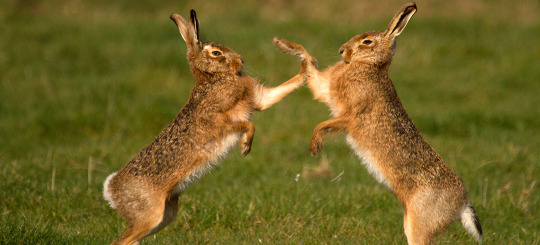
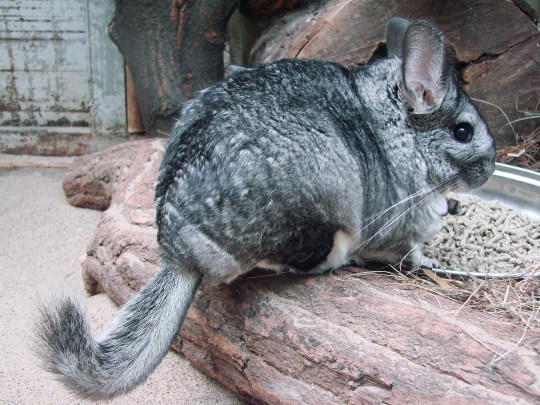
"Glires" is a clade containing the orders Rodentia (rodents) and Lagomorpha (rabbits, hares, and pikas.) Think of it as every animal you'd give buck teeth to if you were drawing them as a cartoon. Rabbits, beavers, squirrels, mice, etc.
There are lots of similarities between the two groups--they're small, they're widespread, they have lots of babies, they've got some big ol' incisors. In fact, until 1912, rabbits and their ilk were considered rodents. Then someone looked at rabbit teeth and was like, "No, these things are pretty different from each other, actually", and put them in a new group called Lagomorpha. Most differences between them stem from the fact that Lagomorphs are designed for eating grasses, while the diets of Rodents vary greatly.
Glires is found within the superorder Euarchontoglires, which also contains tree shrews, colugos, and primates. Homies with Hands, I like to call them, even though some of them don’t really have hands exactly. Rodentia has too many families, and I simply cannot list them all, especially because they are often changing as we learn more about them. Lagomorpha's easy, though: there's Leporidae (rabbits and hares), and Ochotonidae (pikas).
1 note
·
View note
Text
Taxon Tuesday #3: Equidae



"Equidae" is the family containing all living horses, zebras, and asses, as well as a vast array of their extinct relatives. There are so many fossils of their extinct relatives. So many! It's kind of insane. Early in the Cenozoic, equids lived in forests, which were quite widespread. As the earth’s climate cooled, most of those forests became grasslands, and many members of the horse family adapted to life on the plains. All modern equids live in plains, savannas, or deserts.
All living equids walk on one toe: their hoof. Many earlier species had three toes or four, though they didn't necessarily walk on all of them. Equids are hindgut fermenters--they have extremely long intestines that help them absorb all the nutrients from their food (grass and other tough vegetation).
All living equids belong to a single genus called Equus. They're divided into three groups, or subgenera: horses (Equus), asses (Asinus), and zebras (Hippotigris). Equidae belongs to the order Perissodactyla, or odd-toed ungulates, along with tapirs and rhinos. Equids exist in the suborder Hippomorpha (horse-shape), while tapirs and rhinos are in Ceratomorpha (rhino-shape).
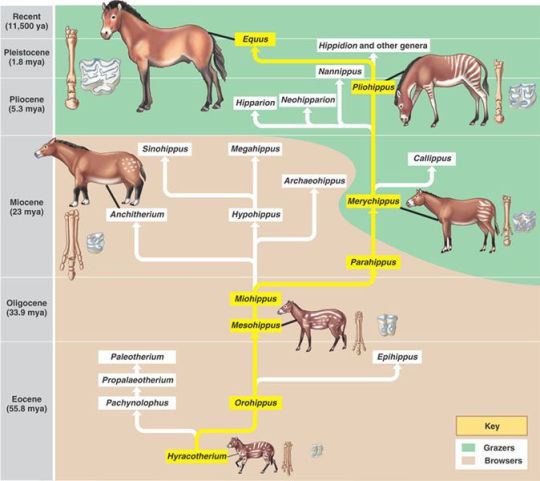
(um sorry the evolutionary tree is so low-res...yikes)
#equidae#equids#horses#wild horses#asses#zebras#perissodactyla#odd-toed ungulates#taxonomy#taxon tuesday
0 notes
Text
Taxon Tuesday #2: Lepidoptera


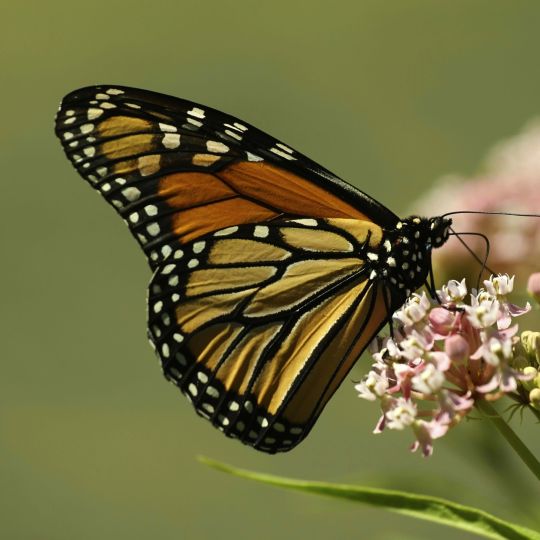
“Lepidoptera” is the order containing butterflies and moths. Well over a hundred thousand species have been described, making them one of the most diverse groups of organisms in the entire tree of life. The first Lepidopterans in the fossil record appear early in the Jurassic, well before the spread of flowering plants.
Both moths and butterflies undergo metamorphosis and have a very distinct larval and adult form. Their bodies are coated in miniscule scales. They are key pollinators and prey animals, but can also be pests in human agricultural endeavors, and parasites to plants and other insects.
Lepidoptera is nested within the superorder Amphiesmenoptera, alongside its sister order, Trichoptera, the caddisflies. This superorder is nested within the larger clade known as Endopterygota, which houses insects with distinct larval, pupal, and adult stages, including wasps, beetles, and ants. Lepidoptera itself is divided into over 100 families. I will not list them all <3
6 notes
·
View notes
Text
Taxon Tuesday #1: Tapirus



"Tapirus” is the genus containing all four species of extant tapirs, as well as a multitude of extinct members (including several who once lived in North America!) Modern-day tapirs are restricted to Central and Southern America, save for Tapirus indicus, who can be found in Southeast Asia.
Tapirs are stocky, fairly large herbivores who inhabit tropical rainforests. As seed dispersers, they are integral members of their ecosystems. The tapirs of 20 million years ago look almost exactly like that ones alive today, which is why tapirs are considered “living fossils". Their own secret language consists of clicks, chirps, and whistles.
Tapirus is a member of the family Tapiridae, a broader group of tapirs and tapir-shaped friends. Tapiridae’s sister family is Rhinocerotidae, the rhinos. These two families, plus the horse family Equidae, make up the order of odd-toed ungulates, called Perrisodactyla.

2 notes
·
View notes